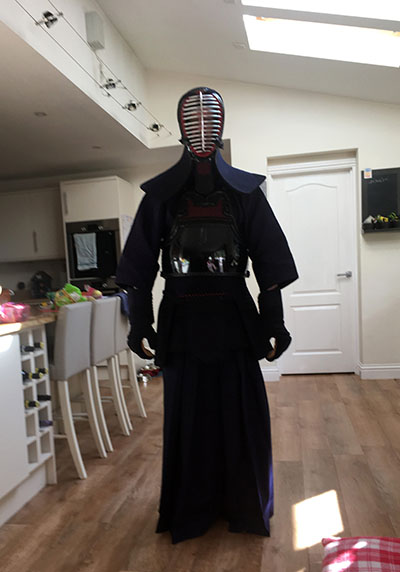Contact jane.playdon@cisi.org if you are a CISI member with a hobby you think will interest other members. You will receive a £25 voucher as a ‘thank you’ if we publish your story
Liam’s firm, Darién Consulting, specialises in investment operations and transformation. Much of Liam’s time recently has been consumed by working with Schroders business consulting and design teams, helping to mobilise a large programme to on-board Lloyds Banking Group’s investment mandates; believed to be the biggest ever such transition in the UK.
But for a few hours a week he doesn’t think about it. “I think of nothing but my kendo practice and the opponent in front of me. The aggression and speed of kendo makes it very easy to maintain focus … sometimes just on getting air into my lungs,” says Liam.
Kendo is descended from traditional swordsmanship using bamboo swords (shinai) and protective armour (bogu). Liam first saw kendo when he spent a month in Japan in 1985 as part of his international business, economics and Japanese degree from Auckland University, New Zealand where he was born and grew up.
He was attracted to kendo by the combination of strenuous physical effort and discipline required: “There is no defence or blocking in kendo – only attack. Advanced practitioners may use techniques that rely on the opponent initiating an attack, but only with the intent of being able to use that as an opportunity to strike themselves.”
He started practicing kendo at the Ichi Byōshi Kendo Club in Aylesbury in July 2018. For the first six weeks, he was allowed to train in western clothing while he focused on footwork and cutting methods with equipment borrowed from the club. “At this point you need two swords: a bokuto wooden sword and a shinai bamboo sword. The bokuto is used to practice kata, which means ‘form’, and is a choreographed series of drills for learning and perfecting kendo techniques; the shinai bamboo sword is used for more energetic practices.”
"There is no defence or blocking in kendo – only attack"
 Once the basics are mastered, the student moves on to more serious kit in the form of a helmet, gloves, breastplate armour including waist/groin protector, kendogi jacket and hakama wide-leg trousers. To become totally kitted out, including armour and swords, a kendo student would spend between £300 and £500: “Some of the armour needs to be a close fit for your body, therefore buying second-hand is tricky.”
Once the basics are mastered, the student moves on to more serious kit in the form of a helmet, gloves, breastplate armour including waist/groin protector, kendogi jacket and hakama wide-leg trousers. To become totally kitted out, including armour and swords, a kendo student would spend between £300 and £500: “Some of the armour needs to be a close fit for your body, therefore buying second-hand is tricky.”
Kendo duelling is called jigeiko, with the winner in a competition being first to two points, says Liam. “To score a point you must make an intentional, accurate strike to one of four designated areas – the head, wrist, torso and throat – using the top-third of the shinai’s ‘blade-side’. All while keeping correct posture and ‘zanshin’ mental state and displaying the required high spirits – kendo is a noisy sport!”
Liam typically does three to six jigeiko a week for one to two minutes: “That may not sound like a lot but by the end I am covered in sweat and trying to suck air through my helmet grill.” Part of the challenge at this point is “to maintain form and focus when you are tired.”
His kendo club is fortunate to have both a top qualified instructor and British-squad member as instructors: “John Bates, our third-dan instructor and Chris Bowden, who fought for Great Britain at the 2018 Kendo World Championships in South Korea. In kendo everyone fights everyone in rotation, no matter what the grade – it is challenging to try to hit most of the class, but facing John and Chris gives you a weekly experience of just how patient, precise and explosive a great cut can be.”
Kendo is for anyone big enough to control a sword, which, Liam says, is roughly from the age of eight onwards: “We have a talented female member in our club who attained Ikkyu grade and is therefore one of our more senior members. There is some advantage to height as that allows you to stretch to the target from further away, but speed and accuracy are more important.”
Injuries can occur: “We are particularly careful in practicing the tsuki attack to the throat. If the attacker misses the armour, the sword can travel under the helmet wings. I’ve had minor injuries twice, once on the right thumbnail because I held the sword incorrectly, and once practicing the eye-to-eye tsubazeriai technique without a helmet.”
In terms of the kendo non-hierachical approach to learning, one could argue that present day corporate and business human resource management could learn a thing or two from it. “In every class the most junior person stands on the right and there is a huge focus on how teachers and students treat those more junior to themselves. It is good for the ego to be corrected by a 10-year-old who has been doing the sport only three months more than you,” says Liam.
This article was originally published in the Q1 2019 print edition of The Review. The print edition is available to all members who opt in to receive it, except student members. All eligible members who would like to receive future editions in the post should log in to MyCISI, click on My Account/Communications and set their preference to 'Yes'.